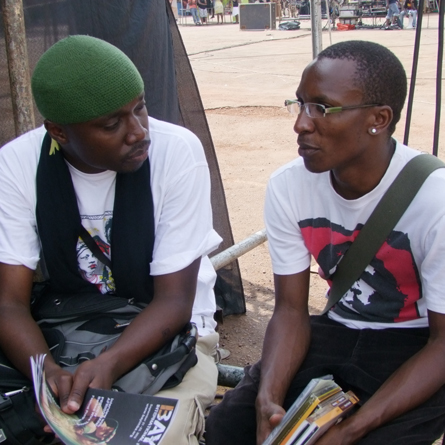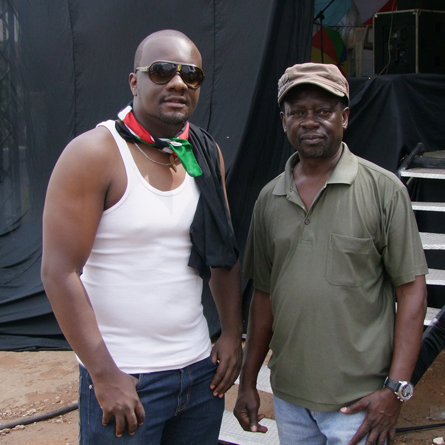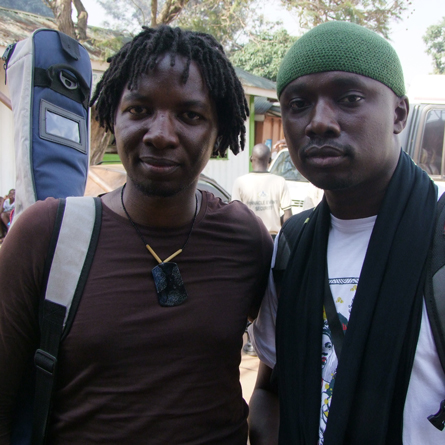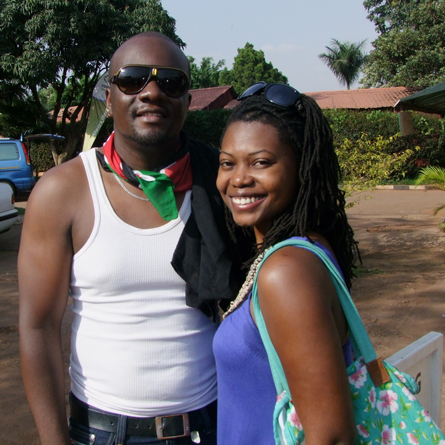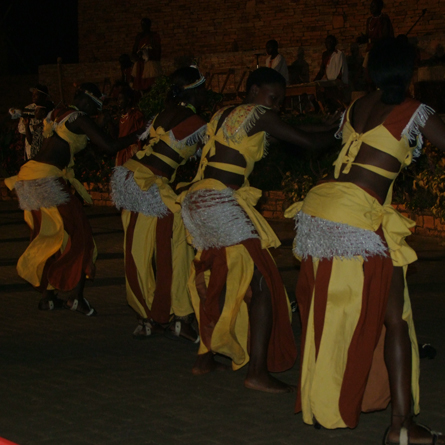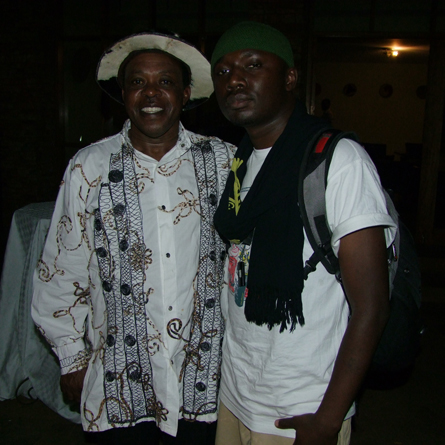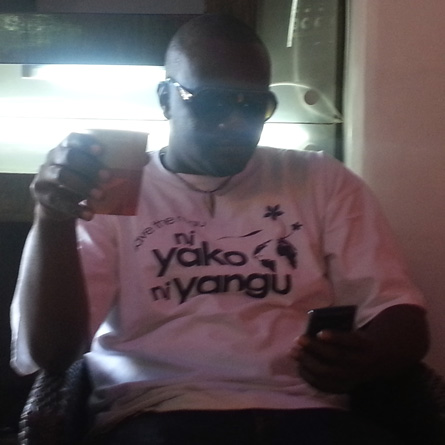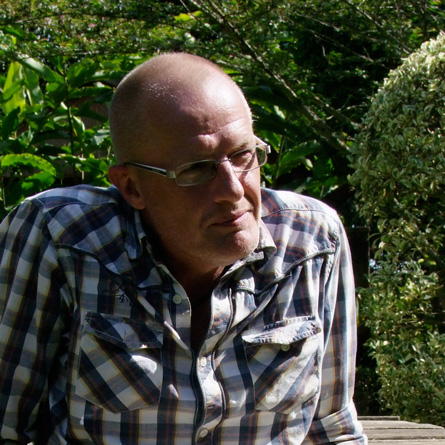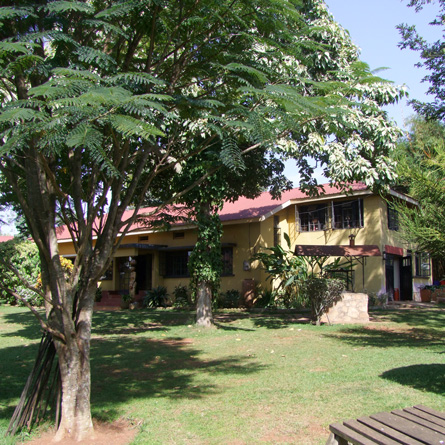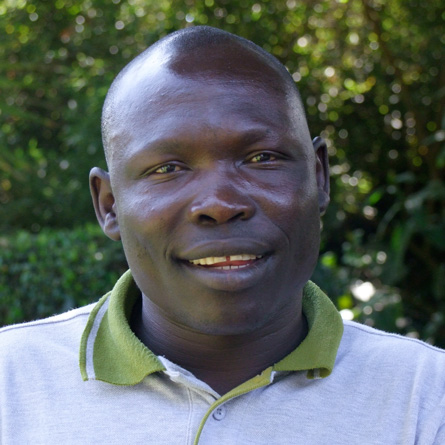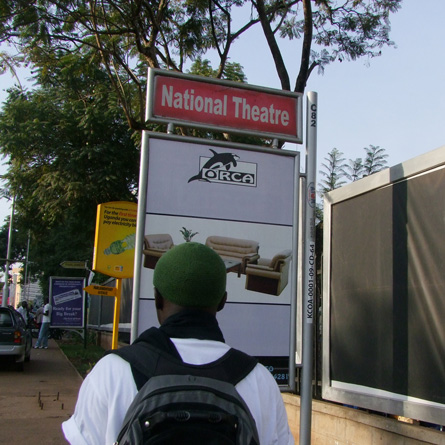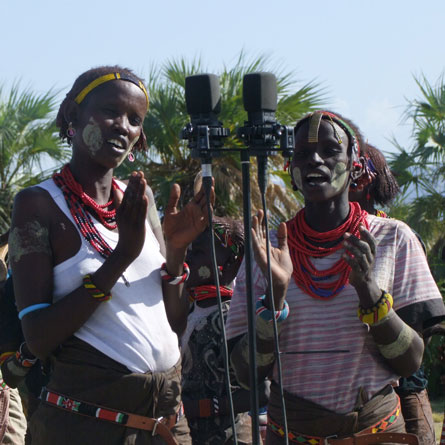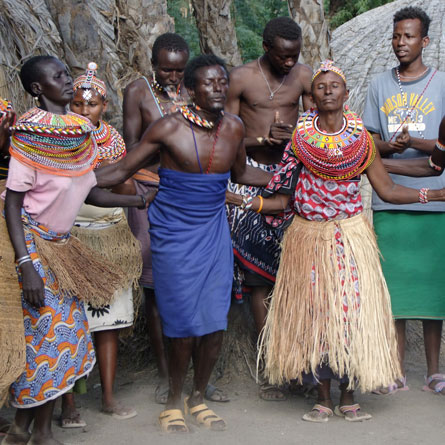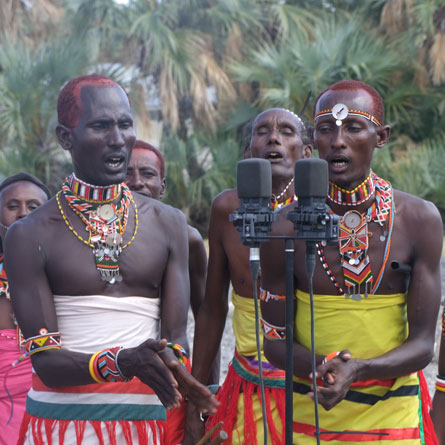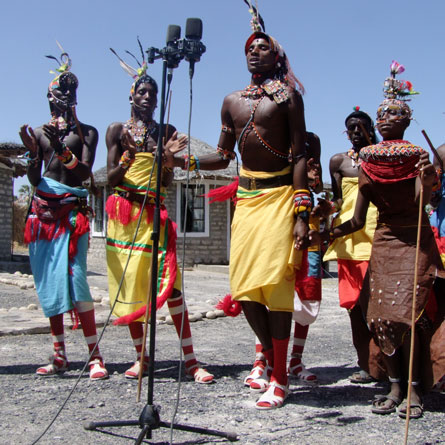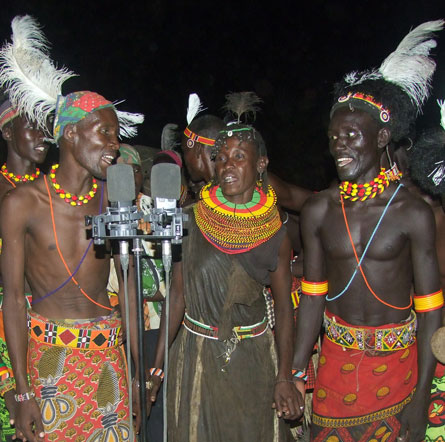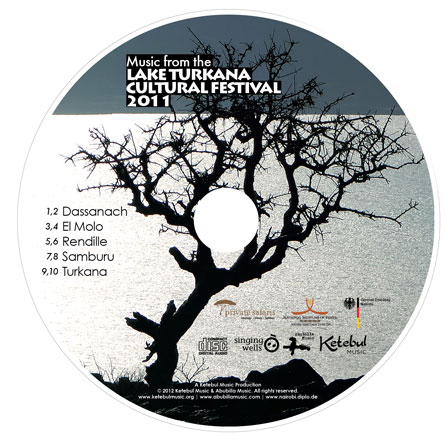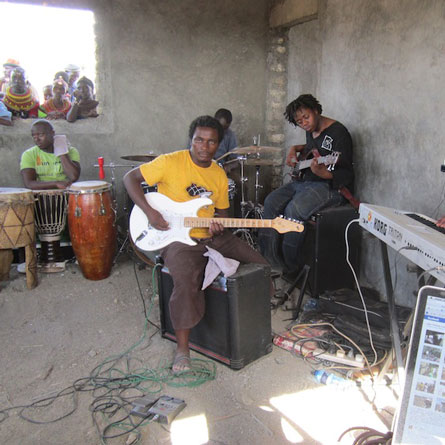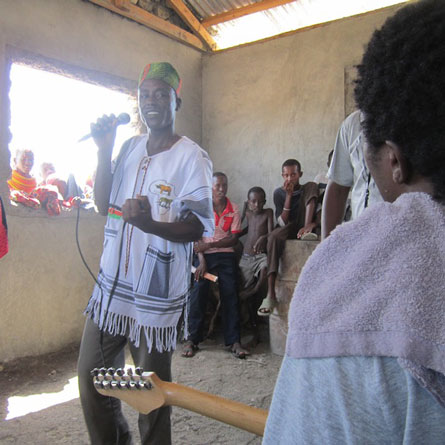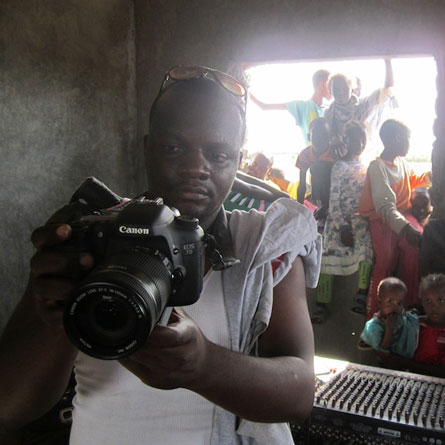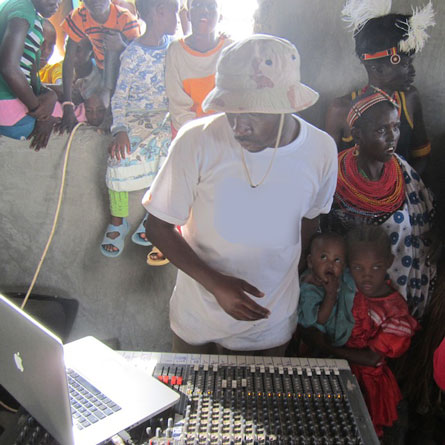Singing Wells Project: Music of Northern Uganda – Recce Day 02: 12/09/23
By Stefano
Kampala – National Theatre: Bayimba Cultural Festival
The next day after a long night of no sleep owing to the noise from the street seeping into my room through the walls and windows, we have a hearty breakfast at the Hotels dining room. If there was any consolation for the sleepless night, then the hearty breakfast more than made up for it. The menu consisted of potatoes, beef stew, fried eggs of choice, sausages, toast and assorted beverages.
We then jumped into a special hire outside the hotel and headed out to the National Theatre to make our appointment with Faisal as planned on the previous day.
Faisal was understandably a busy man that day, seeing as it was the final day of the festival. We had to patiently wait for him to break away from his duties before he could meet with us.
While he attended to his duties, he introduced us to a number of musicians who were at the festival grounds, giving us a chance to network and find out more details about the music from the North.
Some of the musicians we met and chatted with were:
Moses Matovu
A sax player and band leader of Afrigo Band. Afrigo band had been listed in a report by on of our research contacts, Peter Hoesing, as being one of the groups we should try see while in Kampala and probably get some information from the band members
Moses admitted that he was not that well informed about music from the North. He however mentioned a name that kept popping up in most conversations we were having about music from Northern Uganda: Sam Okello Kelo.
Sam Okello, formerly of Ndere Troupe but now with a group called Mizizi had also been mentioned by Peter Hoesing and Godfrey Lubuulwa as someone who would have a wealth of information and experience with music from the North.
Kaz Kasozi
Kaz Kasozi is a musician and producer and the music programmes coordinator for Bayimba Cultural Organization. He was also Tshilas producer: one of the prospective artists we were targeting for our influences programme.
Kaz said he had developed a few contacts in Gulu, Soroti and Lira, and he promised to send me their contacts as son as he had access to his computer later that evening.
He also mentioned that music from Gulu had been adulterated extensively by outside influences and was thus difficult to find a purely Acholi traditional group in Gulu. Like Jan and Dnalega before, he also recommended that we visit Arua.
Kaz also made an interesting observation that most traditional music instruments from all over Uganda were more often than not made in Jinja which was to the eastern side of Uganda.
Tshila
Tshila is a Ugandan singer, songwriter and guitar player that Victoria from Abubila Music had come across being interviewed on an online programme by the BBC called Africa Beats.
Victoria had recommended we check her out as a prospective influences artist. We were lucky to find her at the festival grounds. She had already heard from Faisal that we were interested in meeting her. We had a brief discussion with her highlighting Singing Wells and our influences programme within Singing Wells.
She expressed a strong interest in taking part in the programme. We agreed to meet again when we got back to Kampala from up North.
Meeting with Faisal
We finally got a chance to sit down with Faisal in the late afternoon. From our meeting with him we gathered the following information:
Sam Okello
Sam Okello was probably in UK or Holland and would be back in Kampala from the 29th of September.
Faisal will initiate contact and introduce us via email
He also gave me Sam’s number
Arua
Arua has a large Nubian community with beautiful Nubian music. He also mentioned a xylophone playing group in Arua whose contacts he promised to send to me later that evening.
Gulu
Recommends we visit TAKS Centre in Gulu and meet with Joyce Laker and Daudi. TAKS Centre were Bayimba’s cultural partners who help them program traditional artists and groups from Gulu when Bayimba do their regional festival.
He also recommended recording a musician from Gulu called Peter Otim.
Kampala
Suggests we record a few Kadongo Kamwe groups from Kampala.
Will set up meetings and auditions with 3 Kampala based groups on Thursday at Bayimba offices. He mentions The Planets and 2 other groups for the meetings.
Fixer for the recce
Faisal introduces us to Sylvester, the youth programmes coordinator for Bayimba Cultural Foundation. Sylvester has runs programmes in Arua and Gulu for Bayimba. We ask him to travel with us Monday and he agrees.
Ndere Centre, Ntinda – Ndere Troupe
After our meeting with Faisal, we hooked up with Godfrey at the festival grounds. We had to make a dash to Ndere Centre in Ntinda to catch the evening peformance by Ndere Troupe. It was a half an hour drive to Ntinda and we got there just as the troupe was finishing their first piece.
Ndere Centre is well built and very impressive. There is lush greenery al around and the performances are held in a large outdoor amphitheatre. I later found out that the centre plays host to up to 65 dancers and dance trainees at any given time.
The troupe gave a very exhilarating performance that was a mix of dace, music and oral narratives. They played songs from all the regions and tribes of Uganda. The troupe Director, Rwangeyezi Stephen gave a very captivating oral narrative of each tribe as an intro to every song, touching on the traditions, customs and instruments.
After the performance by Ndere Troupe, Godfrey introduced us to Rwagyezi. We gave him a brief account of Singing Wells and told him we were interested in recording Ndere Troupe as part of our project. We then exchanged contacts with the aim of continuing our discussions further via email correspondence.
Kampala – National Theatre: Bayimba Cultural Festival
Back at the National theatre late that evening, we had a brief meeting with Sylvester to work out logistics for the next day and where we would pick him up from. We were planning to depart Kampala as early as possible the following morning.
We stayed on till the closing act of the festival seeing as it was the final night, before heading back to the hotel.
Click for more information on Ndere Troupe
Click here for more information on Afrigo Band
Click here for more information on Tshila
Click here for more information on Kaz Kasozi
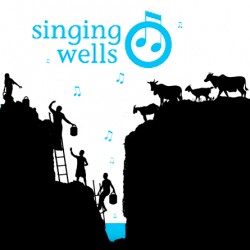
Singing Wells Project: Music of Northern Uganda – Recce Day 01: 12/09/22
By Stefano
In preparation for our November – December Singing Wells Project covering Northern Uganda, Patrick and Steve traveled to northern Uganda via Kampala on a fact finding mission to map out the region and identify performing groups.
The recce was aimed at getting information on the following:
1.Logistics
Air travel
Road Travel and state of the roads
Accommodation
2.Support
Fixers & Cultural Partners
3.Music Performers
Groups
Locations
Singing Wells is a partnership project by Ketebul Music and Abubilla Music that aims at archiving and documenting the rich musical traditions from eastern Africa
Nairobi
Our journey begun early Monday morning with a taxi ride to JKIA. Our flight was scheduled for take off at 7.55am meaning we had to be at the airport at 6.30am.
We arrive at the airport at 6.15am and we are lining up at the check in counters by 6.30am. Due to overbooking and much to our disappointment and inconvenience, we are transferred to a later flight set to take off at 12.55pm.
We spend the entire morning at the airport trying our best to drown our disappointment in coffee and the day’s newspaper.
Entebbe
Finally after a smooth flight (Patrick is not a fun of flying so he might say different) we arrived at Entebbe Airport at 2.10pm. After clearing with customs, which took no time at all, we find Jan’s driver was waiting for us outside the arrivals area.
A short 15minutes drive later and we are seated with Jan at the Airport Guesthouse Entebbe having refreshments and a brief meeting with Jan before proceeding to Kampala. Although this was our first time to meet face to face, this was not our first encounter with Jan.
Jan Willem is the manager of the Airport Guesthouse in Entebbe as well as the Travelers Resort in Kisoro where we had been to in 2011 during our work with the Batwa. He had been one of our logistical partners on the ground giving us information with regards to accommodation and transportation.
We were also lucky that some of the staff at the Guesthouse were very helpful with information about the regions we intended to cover during our visit.
Meeting with Jan, Mary, Rose, Charles and Dnalega Bonnars
From our meeting with Jan we gathered the following;
1.Roads
The roads heading north are in poor state. Jan recommends using land cruiser vehicles for our trip.
There is a new road from Gulu to Soroti but it is rarely used
Drive time from Kampala to Gulu approx 6hrs
Drive time from Gulu to Pakwach approx 4hrs
Drive time from Pakwach to Lira approx 6hrs
Might not be possible to cover Pakwach to Lira on the same day as planned
2.Accommodation
Entebbe
Jan offered the SWP team a discounted rate at the Guesthouse for later that year
Kampala
Good hotels in Kampala would cost more than we had anticipated
Gulu
Accommodation might be a challenge
Few good hotels in the region
Recommends Acholi Inn
Pakwach
Jan has a lodge in Pakwach, Murchinson Falls
He would give discounted rates for SWP
I make a mental note to look at possibility of altering our itinerary so we spend a night in Pakwach instead of Lira.
Lira
Jan was not aware of any hotels in Lira as it was not a common sleep over town.
3.Music and Communities In The Region
Gulu
Tribe Acholi
Instruments: Adungu (traditional harp that comes in varying sizes)
Pakwach
Tribe Alur
Instruments: Agwara (wooden trumpet)
Jan recommends we pay a visit to the manager of Global Village who might be helpful with information on Alur culture and might help identify music groups
Lira
Tribe langi
Instruments: Keme (thumb piano), Bul (drum)
Mary informs us that traditional music in Lira is on the decline and groups might be hard to find
Soroti
Tribe Ateso & Kumams
Instruments: Ateus (a drum similar to the Baganda short drum), Akogo (thumb piano)
Rose describes the dressing of performers as they do the Akogo dance: women wear kangas tied above their breasts and men wear shorts. She recommends we visit the ‘Emorimori’ (tribal chief) for more information.
Arua
Tribe Lugbara
Instruments: Ari (drum), Adungu, Pita (thumb piano)
Arua is not on our itinerary but Dnalega Bonnars describes the music of the Lugbara from Arua with such impressive detail that we are left considering adding Arua to our itinerary.
The Lugbara perform a host of different styles some of which are exclusive to certain age sets and sexes. He describes a dance called Koro that is performed exclusively by the elderly using the adungu and ari. The performers are dressed in special kangas similar to the Ateso for the women and the men wear shorts. They also wear feathers on their heads and shakers on their upper arms and ankles. Dnalega calls it the most beautiful dance. For a man who started off by saying he didn’t know much about the music of the Lugbara, Dnalega’s description of the Lugbara music leaves us with no doubt that we have to visit Arua and witness a performance by the Lugbaras.
Kampala
After the meeting with Jan, we thanked him and his staff for their hospitality and information and departed for Kampala.
Jan had called us a taxi, or as they call them in Kampala, ‘special hire’ and instructed the driver to assist us find suitable accommodation in Kampala.
The distance from Entebbe to Kampala is listed as approximately 40km, but the drive takes much longer and we are left doubting the accuracy of that information. One and a half hours later we arrive in Kampala city centre and we ask our driver to help us find a forex bureau before finding us a hotel. We find most bureaus close early on the weekend. Luckily there was one that operates late at the Nakumatt supermarket complex.
Because we had scheduled a number of meetings at the National Theatre and we also intended to network during the Bayimba Festival, which was taking place at the theatre over the weekend, it was important for us to find accommodation close to the theatre. We informed our driver as such and he said he knew just the place that would be ideal for us. He drove us into an area that resembled Nairobi’s River Road and we ended up checking into ‘’one of the best hotels in Kampala,” according to our driver. By the next morning, I did not share his sentiments at all. While the rooms were spacious and comfortable, the walls were paper-thin. Add to that the noise from the busy street below and finding sleep was a battle that I lost miserably.
Kampala National Theatre: Bayimba Cultural Festival
After we checked in to the hotel and a quick shower to freshen up, we walked down the street and jumped into another special hire and headed to the National Theatre for the Bayimba Festival.
It was 7pm and we were anxious to catch the performance by Jackie Akello who was one of our ‘influences’ prospects. Seeing her on stage would help in gauging her abilities and style and help in making the decision of whether she was the ideal candidate to join us for our trip in December. We however end up listening to her two last numbers while lining up outside at the entry to the theatre. The line of revelers attending the festival was quite long. The sound was pretty good though and apart from the fact that we didn’t actually see Jackie’s performance, what we heard was quite impressive. We later tried to secure a brief meeting with her but we were unable to because she was held up in a PR exercise for on of the festival’s sponsors. Alex from Bayimba promises to secure us a meeting some other day.
We met briefly with Faisal Kiwewa, the founder and Director of Bayimba Festival and set up an appointment for the following day. Faisal was one of our cultural partners in Kampala and he would help us with contacts and information on some of the areas we intended to visit.
We also met and spent some time with Godfrey Lubuulwa, a Kampala based musician from the Baximba Waves. Godfrey had been one of the participants at an accordion workshop that we had held in Nairobi earlier. He was also one of our contacts on the ground helping us identify groups and performers from the regions we intended to visit. He gave us information on one Sam Okello Kelo, a musican formerly of Ndere Troupe who was now with a group called Mzizi Ensemble. Sam was very knowledgeable about the music of Uganda in general and according to Godfrey, he would make the ideal guide and fixer for us during our travels up north. Godfrey informs us that Sam might be out of the country but he would initiate contact with him on our behalf.
The end of the festival performances for the night also marked the end of our first day in our Singing Wells recce. After a brief night in the town and a cold drink to wind up the evening at a local club in Kampala, we retired back to our hotel for some much deserved rest.
Stay tuned for more posts from the recce to northern Uganda.
Click here to view more pictures from the recce on Facebook
Click here for more information on Singing Wells
Click here for more information on Abubilla Music
Click here for more information on Airport Guesthouse, Entebbe

Lake Turkana Festival 2012
By Stefano
In 2011, Ketebul Music under the Singing Wells Project visited Loiyangalani for the Lake Turkana Festival. We recorded music from the different communities that paticipated in the festival, namely the Samburu, the Turkana, the Rendille, the El Molo and the Dassanach.
As a follow uo to that visit, Ketebul Music was again in Loiyangalani for the 2012 edition of the festival. With the support of the Gernman Embassy in Nairobi, we pressed and packaged 100 CDs containing 10 songs from the 5 communites recorded in last years festival. The Cds were presented to the communities during this years festival in an effort to promote better inter tribal relations through music.
Ketebul Music personnel were also accompanied by members of Gravity band, who backed up the 5 communities on stage during festival.
Over a period of two days, Gravity Band rehearsed with the Turkana, the Dassanach, the El Molo and the Samburu in preparation for their performance at the 2012 festival. The performance dubbed ‘Stars Of The Lake’ would also feature Bonaya Doti from Marsabit who tohetherwith his community of the Konso were making their first appearance at the festival.
For more pictures following Ketebul Music personnel throuhg this visit, log on to Ketebul Music’s facebook page here
For mofe on The Lake Turkana Festival 2012 follow this link.
Featured photos by Stefano Sita Nne
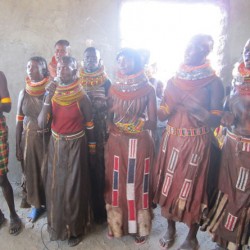
Turkana Cultural Festival
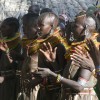
Women from the Turkana community performing at the Turkana Cultural Festival
Ketebul Music engineers recorded audio and video material for the ongoing Singing Wells project during the three days Festival that included performances by the Rendille, El Molo, Samburu, Turkana, Gabbra, and Dassanach. A detailed field report on this will follow shortly.
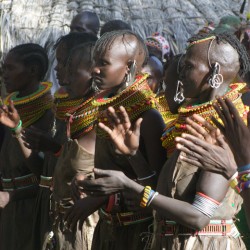
Singing Wells – Ketebul Voices: Steve 64
We are back in Nairobi after a week in the field recording material for the pilot phase of the Singing Wells project. This was a culmination of months of planning and exchange of email correspondence between Abubilla Music and Ketebul Music.
Day 1 – 11.03.247The Briefing
Jimmy and Andy from Abubilla Music, came to Ketebul Studios for a pre travel briefing and to go through the new equipment and software with Ketebul Music engineers on the afternoon of March 27th. They had flown into Nairobi from London the previous evening. I must confess we started off on the wrong footing: all Ketebul engineers were late for the briefing..! Tabu was especially not pleased about that, and Jimmy kept reminding me that I wrote the itinerary and programme (which he said was well written), and should actually take some time to read it (bear in mind that I am the official ‘guy to choke!’).
All in all though, when I made it to the studio, Andy gave me a detailed briefing on all the equipment and a quick run through on Pro Tools. It was pretty impressive, the equipment, two mobile units in easy to carry travel cases, each equipped with a MacBook Pro laptop running on Pro Tools 9, MOTU traveler interface, a 500mb external hard drive, and 2 ART headphone amps. There was also a 2 bags with mic and instrument cables, power extension cables, 8 pairs of headphones, mic stands, boom poles, 2 Rodes NT5 mics with dead cats (no animals were harmed in the acquisition of the dead cats!), 1 shure sm58 and 1 shure sm57 mic, and 2 AKG C414 mics.
Patrick, our video guy, also made it to the studio a short while after me, and Jimmy had to almost beat him off with a stick to keep him away from his (Jimmy’s) Canon 5D camera. Pato was drooling all over it, and we had to pry it off his hands with a crowbar!
The second four wheeler for the road trip was delivered, and Maddo, chairman of Ketebul Music board of directors, had to drop off the owner who intended to test Maddo’s skills behind the wheel. Tabu took off with Jimmy and Andy and headed to Sippers for drinks and dinner and a musical performance by Samba mapangala, Winyo, and Ayub Ogada, that he had organized to welcome our friends from Abubilla. We all joined them later, and I couldn’t believe how late it was when we finally left to go home. Jimmy made a point to check with me whether I knew when we were to depart from Nairobi according to my itinerary. Yes, Jimmy can be a funny guy.
Day 2 – 11.03.28: The Road Trip to Malindi
On the day of departure, I made a point to make it to the studio way before 9am to avoid the embarrassment of the previous day. Everybody finally checked in and the equipment and luggage was loaded into the two vehicles. Both cars were fuelled to capacity and we hit the road for the first part of our journey, Nairobi to Voi 15min to 11. We were split four people per car with Tabu on the wheel, Jimmy, Andy and Willie Bembe in car number 01, and Maddo on the wheel, Winyo, Pato and I in the air conditioned car number 02, which was equipped with a GPS unit courtesy of Maddo, the chairman or as he prefers to be called “The Leader and The Guide!”
4 and half hours and 322 km later, we made a stop in Voi town for lunch. Everyone had some food apart from Tabu. I have known Tabu since 2005, and I can count the number of times I have seen him having a meal on 1 hand! After refueling car number 02 (it must have been guzzling the fuel because of the AC), we set off for the second leg of our journey, Voi to Mombasa.
Salif Keita’s ‘M’bemba’ CD and Winyo’s in production CD ‘Benga & Blues’ proved to be the favorite cruise music as we kept on switching between the two. Though I must admit I was riding shotgun and had control over the car stereo and I was just playing two of my favourite CDs. No one objected to my choice of music so I guess they all liked it! The cold tusker s we picked in Voi also helped to while away the hours. Unfortunately for The Leader and The Guide, he was the designated driver, and could only enjoy the sight and sounds of us downing the tuskers.
We finally made it to Mombasa a little after 7pm and it was unanimously decided we proceed straight to Malindi, our third and final leg of the trip. Tabu in car number 01 had the pedal to the metal and was almost 45 minutes ahead of us. My guess is finally the hunger had kicked in, and he couldn’t wait to get to Malindi and some food.
We made it to Malindi around 9.30pm. No one knew the exact location of Paradise Hotel and The Leader and The Guide’s GPS couldn’t help us either. Luckily for us, while we were refueling car number 02 at Watamu, a friend of Pato’s who lives in Malindi just happened to come by the station for fuel too. He took us to Paradise Hotel (which turned out to be a disappointment for all), where we found Tabu and his team had already arrived and were a couple of tuskers down. After unpacking all the equipment and checking in to our respective rooms, Pato ,Winyo, Willie Bembe and I set off to get diner for everyone. The restaurant at Paradise had closed already, so we had to get some take out from elsewhere. It was pizza all round except for Winyo and Tabu who opted for chicken and ugali.
Day 3 – 11.03.29: Recording Day 01 – Gede
Breakfast the following morning and it was clear from everyone that Paradise Hotel was not living up to its name. From broken bathrooms and leaking toilets, to malfunctioning ACs (do note that the temperatures in Malindi at night were around 31°C and humid), Paradise Hotel scored a minus 4 on the 1 to 10 scale, 1 being disastrous.
Despite all the mishaps with the Hotel, we were all excited to be heading out for our first day of recording. But first we had to change a flat tyre on car number 02. Half an hour or so later, we were all geared up and ready to go. Jesse, who had just arrived after taking the night bus from Nairobi to Malindi, joined us in car number 02. First stop was Watamu at the fuel station to fill up the cars and Jenny, our beloved and reliable generator, and also to pick up our man on the ground, otherwise known as The Fixer, Deche. He had been on the ground in Malindi, Kilifi, Kaloleni and Kwale, a week earlier, liaising with the groups we were going to record in the villages. We then proceeded to Gede stopping briefly on the road to pick up Bado, the son to Mzee Nyere wa Konde, singer and group leader of Mwanzele Nyere wa Konde Music Club in the village of Sita. We quickly identified our recording station that would work well for the sound and also provide the perfect backdrop for the video. Then it was all hands on deck, putting up the tent, setting up the recording station, and powering up good old Jenny as the performers got ready and took their position.
When we finally got to recording, the sound was amazing. The equipment worked better than expected, and the performance by Mwanzele Nyere wa Konde Music Club was out of this world. They performed three songs in the Mwanzele style, a polyrhythmic groove heavy on shakers and punctuated with foot stomping and clapping. Andy manned the recording station, giving us Ketebul engineers a practical run through of the equipment. A moment of magic followed their performance when they were joined by Winyo on an impromptu off the cuff performance. The blend of Winyo’s guitar and melodic voice with their harmonies and percussion cannot be adequately described with words.
This was then followed by a performance by Zaire Ndidingwa led by Fundi bin Kalale. They called their style Ndidingwa and consisted of shakers and a whistle.
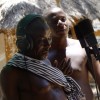
Mzee Nyere wa Konde and his son Bado
Just before we left Sita, we were welcomed to generous helpings of ‘madafu’. This is the juice from almost ripe coconuts, a delicacy in the coast of Kenya. Then it was back to Malindi after a touching farewell from Mzee Nyere wa Konde. We made another stop at the fuel station in Watamu to get the flat tyre fixed. Maddo and I stayed behind to wait for the wheel to be fixed while the rest of the lads jumped into a tuk tuk (3 wheeled motorbike taxi) and headed to the hotel.
Day 4 – 11.03.30: Recording Day 02 – Kilifi
Fast forward to the next day, everyone was glad to be checking out of Paradise Hotel. It was going to be a pretty long day; our itinerary for the day was to start in Kilifi to record 2 groups then drive all the way to Kaloleni in Mombasa for another two groups. Time was of the essence, so an early departure was in the books. Breakfast was a quick affair and we were soon on the road to Killifi. We made a brief stop at Pwani University to pick up Deche the fixer and replenish our water supplies, and then proceeded to the village of Kibarani. Set up was done in a matter of minutes, as the village kids gathered around to see what we were up to.
The first group of the day was Chechemeko Raha, led by Bahri wa Katana. Their style of music was called Chechemeko, and like most coastal sounds, was heavy on percussion, maboum boum drums accompanied by a horn made out of a goats horn called ‘Gonda’. This was a challenging recording because their lead singer sang very softly and the drums were really loud leaving his vocal drowned. So we had to mount one of the Rodes NT5’s on the boom pole, and I drew the short end of the stick and ended up on the boom mic duty. I am still waiting for the Chinese masseuse I was promised…
We were all mesmerized with the group’s last performance, when the gunda player displayed cat like agility with his high kick dancing similar to capoera. This was no simple feat considering that the guy looked to be in his late forties to early fifties!
We quickly switched set for the benefit of the camera crew and recorded the second group of the day, Mzinga, who proved to be another of our favorites especially their lead singer, Alphonce Kazungu. He was a very passionate singer with an amazing voice. We had to remind him over and over to face the mic though, because he kept turning to join the rest of the group in their dancing which they called Kiringongo. This showed us the need to have lapel mics in the future, to enable the performers give their most natural and comfortable performance without compromising on sound quality. Mzinga were accompanied by a small wooden xylophone, the marimba.
After four captivating numbers from Mzinga, we quickly pulled down the set and set off for our second location. The drive would take us to Mombasa,where we would end up in the most interesting set of all so far. Junda.
We first drove in to what seemed to be a very busy township with a very steep and treacherous gravel road to drive on. Everyone was worried about where we were going to set up and record from. Katana bin Kalama, the flamboyant leader of Supaki Kalaza, one of the groups we were to record that late afternoon came up with a brilliant solution: he took us to their rehearsal spot, which turned out to be a dried out seasonal river bed. The stench of dead fish was overpowering, but visually, we couldn’t have asked for a better set.My first worry was where to place Jenny, the place was wide open and we didn’t have anywhere to shield Jenny and minimize the noise. We found a spot downwind behind some bushes, and Maddo parked car number 02 in between our recording station and Jenny, to try and break the path of the sound. Jimmy was concerned about the amount of human traffic we had already attracted. There were kids everywhere and we could see people coming down into the river bed from the village up above in droves. We set up quickly on the back of car number one, it was now early evening and the sun wasn’t blazing hot, so we saw no need to put up the tent. We were also trying to get some recording done before sun down so we wanted to get up and running ASAP.
Supaki Kalazi played for songs in the Mwanzele style. Every now and then, a motorcycle would ride past, and we would all cringe knowing the sound would definitely leak into our recording.
Then came what turned out to be everyone’s favourite group on the trip, Sengenya, led by Munyaka Chimenga. This group was bursting with such infectious energy and they kept going on and on like the energizer bunny! With two ngomas, a metal sheet plate played with two sticks, and such elaborate shakers on the legs of the male dancers, Sengenya played a very complicated mix of dance and percussion that had the whole crowd of almost 120 people applauding their every move..When we finally managed to get them to stop, they insisted on doing one last number for us to join them in dance. I was dragged into the dance and forced to expose my two left feet. Tabu and Winyo gave a good account of themselves with the shoulder shaking dance (which I must point out though is very similar to the dance style of the Lake Victoria region where both Tabu and Winyo hail from). Jimmy gave it his best shot while Andy and the rest of the lads suddenly became ‘busy’ with the equipment.
This was an epic conclusion to a very long day.
With just about half an hour of sunlight left, we quickly pulled down the set and set off to catch the ferry in Likoni, and cross over to the south coast. It would have been a short drive to Likoni, but Tabu missed a turn and we were forced to take a longer route to avoid getting caught up in the traffic. After a brief stop to refuel the cars, we finally made it to Likoni ferry, and joined a long queue of cars waiting to board the next ferry for the short crossing to the mainland.
The drive to Diani on the south coast seemed to take forever. Exhaustion from the long day was creeping up on everyone. We checked in to the Indian Ocean Beach Resort in Ukunda, and after quick showers, we all gathered at the hotel’s restaurant, and shared our best and worst jokes over dinner and
a much waited for, cold tusker.
Day 5 – 11.03.31: Recording Day 03 – Kwale
Breakfast the following morning was taken leisurely. This was our last day and our set was only 15 minutes or so away, so we could afford to take it somewhat easy. After breakfast it was the same routine again: marshal up the troops to Jimmy’s room for the equipment, and load it onto the cars.
We then drove out to Diani, found an ATM for Jimmy and Andy to get some cash, replenished our water supply, and drove to our fourth and final village, Vuga in Kwale.
We set up on the back of car number one, under a tree shade. We were even lucky to have electricity this time around. We plugged into the house of who seemed to be the village elder, and were ready to go in minutes. Jimmy was in love with this set, our backdrop was a small house with light blue
walls, and the red earth was slowly creeping up on the sides of the walls. The first group of the day was called, Zigidigi Cultural Troupe, led by Matano Mwachiti. They had an array of drums and a calabash like instrument that the player blew into through a thick pipe and it produced an interesting bass sound. They also had a flute, the Chivoti and the player played some interesting melodies. The ladies in the group looked very happy as they danced and sang. And as soon as they finished, they were again joined by Winyo for another magical moment as we waited for the second group to arrive on set.
When they arrived, we again switched the set for a different backdrop for the video. The final group was called Muungano Kayamba, They came with all manner of props for their performance, including a creepy looking life size baby doll that reminded me of Chucky. Their music was based on the Kayamba, a shaker common in most Mijikenda tribes. They performed a harvest dance which had one of the ladies carrying the creepy doll with the other ladies dancing around her. The three kayamba players laid down a very complicated and tight rhythm accompanied again with the chivoti.
After their performance, and another jam with Winyo, Jimmy bought a couple of kayambas and got an impromptu lesson on playing one. We packed up the set and hit the road for Diani. We stopped for lunch at a place called African Pot that Maddo had spotted on our way to Kwale. The food was
particularly good, and served as the perfect ending for the day.
At the hotel, we quickly set up on the beach just outside Jimmy’s cottage, for a recording with Winyo and Andy. Pato and I then drove Winyo to hospital in Diani to have his tooth checked. He had knocked himself on the bed the previous evening, and his tooth was hurting. It was a long wait for the dentist at the hospital; he had gone for the day and had to be called back. When he came back, he referred Winyo for treatment in Nairobi seeing as there was no time for him to do a full procedure.
The three of us then had dinner at Diani Campsite, a short distance from the hospital, and then drove back to the hotel. Everyone had retired to bed apart from Maddo, Deche, Willie Bembe, and Jesse. We joined them for a few tuskers before Deche and Jesse went out for a night in Diani. We had an early departure planned for the morning; we had to be in Nairobi at 7.00pm for a meeting with one of our prospective donors, so we soon all retired for the day.
Day 6 – 11.04.01: Diani to Nairobi
The following morning we checked out of the hotel and loaded up the equipment and luggage into the cars. This time around I joined Tabu, Jimmy and Andy in car number 01 to talk shop on the drive back to Nairobi. Deche rode with us to Mombasa where we dropped him off.
The drive to Voi served as a chance for us to reflect on the project and pin point areas we needed to improve on. Jimmy also took the chance to interview Tabu, Andy and I on our backgrounds and our reflection on the project. We made a brief stop in Voi for a toilet break but we were all in
agreement to proceed to Nairobi.
Fast forward, 7.00pm in Nairobi. Our rendezvous for the meeting was Habesha, an Ethiopian restaurant in Kilimani. We had diner then proceeded to Jimmy and Andy’s hotel, Fairview, for the meeting and to return car number 02.
Exhausted from the long drive and the project in general, I went home for a much deserved rest.
Day 7 – 11.04.02: 71 Hours to Monday Recording Session @ Ketebul Studios
The final day of the project, was spent at Ketebul Studios, recording 71 Hours to Monday, an Abubilla song that they feature artistes from wherever their travels take them. While Andy recorded Bishop on bass, Winyo and Makadem on vocals, and the legendary Ayub Ogada on nyatiti, Jimmy met with Joy of the Godown Arts Centre to share his views on the centre. Later he shared with me his thoughts on the direction to take when compiling the material collected for output on DVD, CD, and booklet.
Soon it was time for Jimmy and Andy to leave and catch their plane back to the UK that evening. We dropped them off at the airport, not saying goodbye but see you later. The main Singing Wells project is set for November, which is just around the corner.
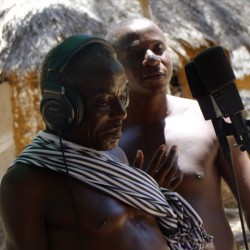
Singing Wells Project
The Singing Wells is a project dedicated to the preservation of Kenya’s music heritage at its very heart (read more on the Singing Wells here). Ketebul Music and our partner Abubilla Music (www.abubillamusic.com) will today embark on a trip to Malindi on the pilot stage of the project, aimed at putting the equipment and the personnel to the test. Jimmy Allen and Andy Paterson from Abubilla Music join Ketebul Music personnel on a 5 day moble recording trip of the Kenyan Coast.
Equipped with two mobile recording units and top of the range software, the Singing Wells project is definitely off on a good start.

